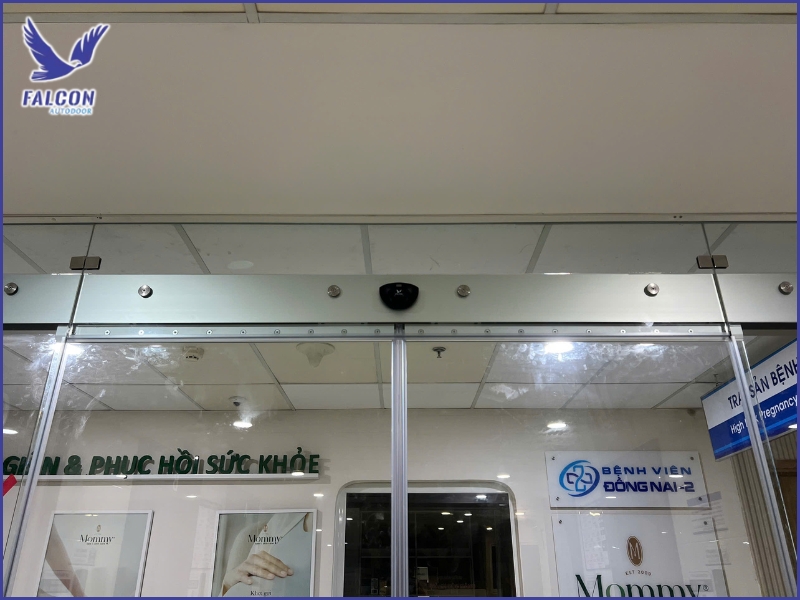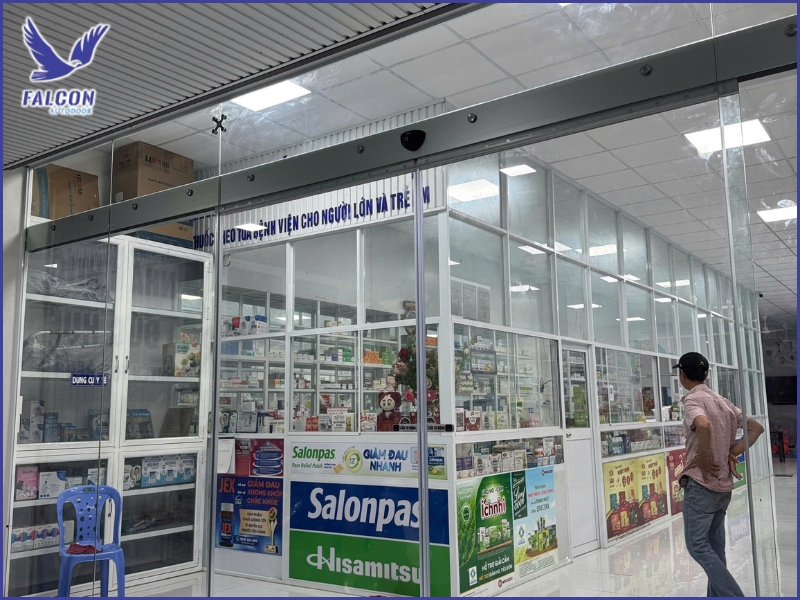How to identify genuine automatic doors and low-quality products
Automatic doors are becoming increasingly common, yet the market still contains many low-quality products that pose risks for buyers. In this article, Thuy Linh Long guides you through the key indicators that help distinguish genuine automatic doors from poor-quality alternatives, ensuring durability, safety, and long-term performance.
1. Why it is important to distinguish genuine automatic doors from low-quality ones
The market offers a wide range of prices and models, making it difficult for users to identify which products meet proper standards. Knowing how to differentiate helps prevent safety hazards, avoid early failures, and maintain stable long-term operation.
1.1 Risks of using counterfeit or low-quality automatic doors
Low-quality doors often produce loud noise, operate inconsistently, and degrade quickly after short-term use. Weak motors, unstable components, or poor wiring may cause the door to jam, reverse unexpectedly, or malfunction in crowded areas, increasing safety risks for users.
1.2 Why origin, standards, and components matter
Genuine automatic doors always come with clear technical specifications, synchronized components, and certified safety standards to ensure durability and continuous operation. In contrast, low-quality products lack authentication, use mixed or substandard motors, and rely on cheap materials that deteriorate quickly and complicate future maintenance.
1.3 Early warning signs many buyers overlook
Common warning signs include unusually low prices, missing electronic warranty labels, or installers who cannot provide detailed configuration documents. Ignoring these signals often leads buyers to mistakenly choose poor-quality products, resulting in high repair costs and early replacement in the future.

2. How to identify genuine automatic doors through components and construction
Genuine automatic doors feature high-quality finishes, synchronized hardware, and transparent origin information. By checking each core component, you can quickly distinguish genuine products from low-quality ones, which typically rely on cheap, inconsistent, and easily worn-out materials.
2.1 Motor
A genuine motor runs smoothly with stable torque and displays a clear model code, serial number, and technical label. The housing is solid, precisely machined, and free of vibration during operation. Low-quality motors often have thin casings, loud noise, unstable movement, and no identifiable specifications.
2.2 Controller
A genuine controller includes security seals, QR codes, and traceable serial numbers. Its circuit layout is clean and organized, with model codes matching the technical documents. Poor-quality controllers usually lack anti-counterfeit labels, have messy circuitry, and are prone to frequent operational errors.
2.3 Belt, rail, and roller
High-quality belts offer strong elasticity, smooth surfaces, and uniform thickness for reduced vibration. Genuine rails are anodized or powder-coated for stability, while high-grade rollers move quietly without friction noise. Cheap alternatives often stretch quickly, bend easily, or wear out after short-term use.
2.4 Safety sensors
Genuine sensors provide fast response, accurate motion detection, and verified safety certifications. Low-quality sensors are slower, less accurate, and prone to false signals, increasing the risk of door collisions, abrupt stops, or unsafe operation.

3. Identifying low-quality products through performance and build quality
Low-quality automatic doors reveal weaknesses during operation from noise and vibration to instability in opening and closing. Observing these indicators helps identify unsafe products before long-term issues occur.
3.1 Excessive noise, vibration, and unstable speed
Low-quality doors often produce noticeable noise, shake during opening and closing, or change speed unpredictably. These issues result from weak motors, poor-quality belts, or unsynchronized components that fail to support smooth operation.
3.2 Thin motor housings, poor materials, and loose assembly
Counterfeit motors usually have thin, poorly machined casings with uneven joints, rough edges, and weak fastening points. Such details indicate low durability and a high likelihood of early mechanical failure.
3.3 Faulty controllers requiring frequent resetting
Low-quality controllers often lose calibration, require frequent resets, or cause the door to stop or reverse suddenly. Unstable circuitry and low-grade sensors lead to inaccurate motion control and increased operational risk.
3.4 Rapid deterioration after short-term use
Common issues include stretched belts, worn rollers, noisy rails, or misaligned tracks within months of installation. Low-quality systems degrade quickly, raising repair costs and significantly shortening overall lifespan compared to genuine products.

4. Verifying authenticity through documentation and certification
Documentation is essential for identifying genuine automatic doors. Authentic products always come with clear and complete paperwork, while poor-quality alternatives often lack proper certificates or provide questionable documents.
4.1 Electronic warranty labels and QR verification
Genuine automatic doors typically include electronic warranty seals that allow users to scan QR codes for instant verification. Details such as model, activation date, and distributor information are fully displayed. Counterfeit products often lack QR codes or provide invalid labels.
4.2 CO - CQ - official manufacturing certificates
Authentic products come with CO (Certificate of Origin) and CQ (Certificate of Quality), ensuring standard compliance. All documents must match the actual models installed. Low-quality products often lack proper certification or use unverified documents.
4.3 Transparent contracts with clear configuration details
Reputable suppliers list all technical configurations including motor, controller, belt, and accessories in the contract. Every model must match the product labels. Low-quality suppliers often give vague quotations or secretly swap components during installation.
4.4 Official distribution channels and maintenance commitments
Genuine products are distributed through authorized dealers offering professional installation, scheduled maintenance, and clear warranty policies. Unofficial sellers typically avoid after-sales commitments and may refuse warranty service when issues arise.

5. Comparing genuine automatic doors with low-quality products
A direct comparison across essential criteria helps clarify the differences between genuine automatic doors and low-quality alternatives commonly found on the market.
|
Criteria |
Genuine automatic doors |
Low-quality automatic doors |
|
Motor - noise - smoothness |
Powerful motor, quiet operation, minimal vibration even under heavy use |
Weak motor, noisy, vibrates easily, degrades quickly |
|
Controller stability & safety |
Stable processing, fast response, reliable anti-crush features |
Frequent errors, resets often required, unsafe control |
|
Opening/closing speed |
Smooth, consistent motion with no jerking |
Slow, inconsistent, prone to sudden stops |
|
Component durability |
High-quality, synchronized components, slow wear rate |
Cheap materials, belts stretch quickly, rollers and rails degrade fast |
|
Warranty & replacement parts |
Clear warranty, genuine replacable parts always available |
Poor warranty, incompatible or hard-to-find parts |
|
Long-term operating cost |
Low maintenance, long-term stability |
High repair cost, short lifespan, repeated failures |

Genuine automatic doors ensure long-term safety, stability, and cost efficiency, while low-quality products pose significant risks and hidden expenses. By understanding the warning signs and verifying components, documentation, and performance, you can confidently choose the right system for your building.
If you need help inspecting an existing system or selecting a genuine automatic door, contact Thuy Linh Long for a full assessment, pricing guidance, and complete installation solutions tailored to your project.
THUY LINH LONG SERVICES TRADING COMPANY LIMITED
DISTRIBUTOR
Address: 243D Vuon Lai Street, Phu Tho Hoa Ward, Tan Phu District,
Ho Chi Minh City, Vietnam.
Tel: +84 28 22497999
E-mail: cuatudong24h@gmail.com
SUPPLIER
KUM YANG MATERIALS CO.,LTD
Address: 124-60, Myeongdong-ro, Hallim-myeon,
Gimhae-si, Gyeongsangnam-do, 50851, Korea.
Tel: 82-55-345-8380










